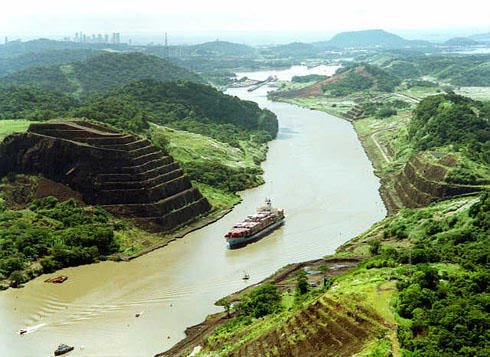Panama Canal

Tuesday, May 22, 2012
PP Notes Mao
China under Mao Zedong 1949 - 1976
Outline
GMD-CCP Civil War (1946-1949)
Recovery and Socialism (1949-1956)
Rethinking the Soviet model (1956-1957)
Great Leap Forward (1958-1961)
Recovery & growing elite division (1962-5)
Great Proletarian Cultural Revolution (1966-1976)
Anti-Japanese War (1937-1945)
Civil War (1946 – 1949)
GMD: Guomindang (Nationalist Party)
Chiang Kai-shek (President)
CCP: Chinese Communist Party
Mao Zedong
“War of Liberation”
Mao Zedong
A revolution to remove “3 big mountains”
imperialism
feudalism
bureaucrat-capitalism
A “United Front” of …
workers
peasants
petty bourgeoisie and national bourgeoisie
People’s Republic of China
1949-10-01, PRC, Beijing
Chairman: Mao Zedong
5-Star Red Flag
Republic of China government retreated to Taiwan
Economic Reconstruction 1950s
Soviet Union model and assistance
land reform (eliminate landlord class)
heavy industry (state-owned enterprises)
First National People’s Congress (1954)
PRC Constitution
Zhou Enlai
Premier
Foreign Minister
Great Leap Forward (1958-1960)
abandon the Soviet model of economic development
Soviet “scientific planning”
mass mobilization
people’s communes
Great Leap Forward (1958-1960)
unrealistic output targets
industry
agricultural and human disaster
Growing Division (1962-1965)
Mao Zedong vs. Liu Shaoqi and Deng Xiaoping
charismatic leadership vs. bureaucracy
Cultural Revolution (1966-1976)
Great Proletarian Cultural Revolution
commitment to revolution and “class struggle”
power struggle to succeed Mao
Phase I: the rise and fall of “red guards”
Phase II: the rise and fall of Lin Biao
Phase III: the rise and fall of the “Gang of Four”
Phase I: Red Guards (1966-69)
Phase I: Red Guards (1966-69)
Purge of party cadres
Liu Shaoqi and Deng Xiaoping
Purge of intellectuals
Phase II: Lin Biao (1969-71)
the putative successor to Mao Zedong
the cult of personality around Mao
In 1971 Lin allegedly tried but failed
to assassinate Mao
to flee to Soviet Union (“9.13”)
“9.13” eroded the credibility
of the entire leadership
of the Cultural Revolution
Phase III: the “Gang of Four”
1972 – 1976
power struggle between
the radical “Gang of Four”, led by Jiang Qing, Mao’s wife
the “moderates”, led by Premier Zhou Enlai
the fate of Deng Xiaoping
Diplomatic Breakthrough
1971, PRC became the representative of China in UN (replaced ROC)
Diplomatic Breakthrough
1972, President Nixon visited Beijing
Mao and Zhou Died in 1976
Turning point in China’s postwar era
“Gang of Four” were arrested
End of the Cultural Revolution
Mao’s legacies
Reforms and Opening up
The 3rd Plenum of the 11th CCP Central Committee in 1978
Deng Xiaoping’s ascendancy
economic modernization became focus
US-PRC diplomatic relations in 1979
Subscribe to:
Post Comments (Atom)
No comments:
Post a Comment